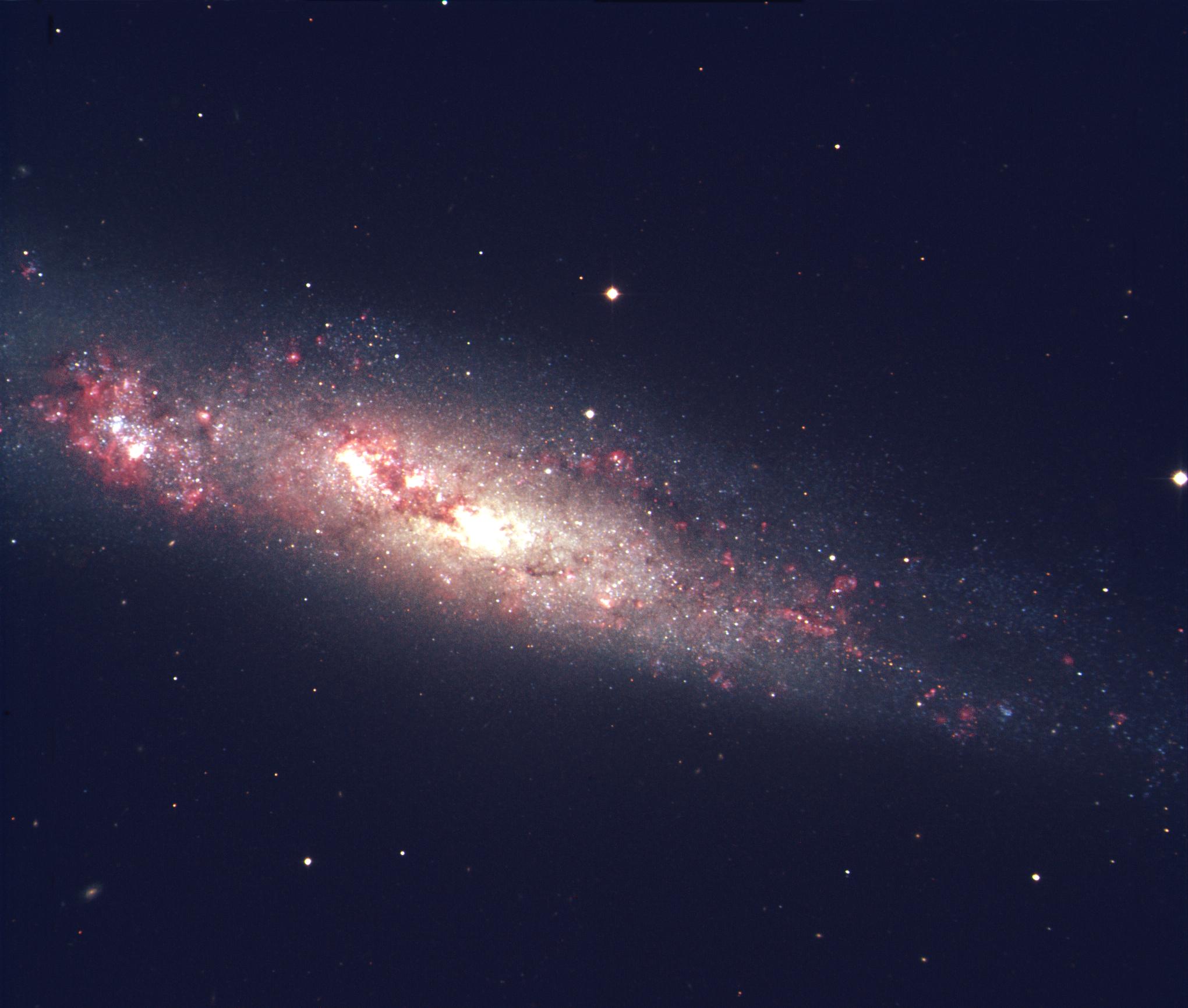







| BOOKS | F. A. Q. | ARTICLES | TALKS | ABOUT KEN | DONATE | BEYOND OUR KEN |
|---|
By Ken Croswell
October 26, 2006

Image from the National Optical Astronomy Observatories/Association of Universities for Research in Astronomy/National Science Foundation.
For the first time, astronomers have detected Cepheids in the Sculptor group galaxy NGC 55 and used these cosmic yardsticks to measure its distance. That distance matches the distance of the spiral galaxy NGC 300, suggesting the two galaxies may orbit each other.
The Sculptor group is the nearest galaxy group to the Local Group and contains five major galaxies: NGC 55, NGC 247, NGC 253, NGC 300, and NGC 7793. Except for NGC 247, all of these galaxies reside in the constellation Sculptor, hence the group's name.
In the past, astronomers have found Cepheids in NGC 300, a spiral that looks like M33, a galaxy in the Local Group. Cepheids are pulsating yellow supergiant stars that reveal distances to other galaxies. The current Cepheid distance to NGC 300 is 6.1 million light-years.
Now Grzegorz Pietrzyński at the University of Concepción in Chile and his colleagues in Chile, Poland, and Hawaii have used the Warsaw 1.3-meter telescope at Las Campanas Observatory in Chile to detect 143 Cepheids in a second Sculptor group galaxy, NGC 55.
 NGC 55 is an irregular, edge-on galaxy that resembles a
larger version of the Local Group's Large Magellanic Cloud: it
is full of gas and young stars, including Cepheids. The Cepheids
reveal that the distance to NGC 55 is 6.2 million light-years,
nearly the same as the distance to the spiral NGC 300. The
astronomers will publish their report in the December 2006 issue
of The Astronomical Journal.
NGC 55 is an irregular, edge-on galaxy that resembles a
larger version of the Local Group's Large Magellanic Cloud: it
is full of gas and young stars, including Cepheids. The Cepheids
reveal that the distance to NGC 55 is 6.2 million light-years,
nearly the same as the distance to the spiral NGC 300. The
astronomers will publish their report in the December 2006 issue
of The Astronomical Journal.
"It's a nice piece of work," says Barry Madore, a Cepheid expert at the Carnegie Observatories in Pasadena, California. However, Madore notes that NGC 55 is an edge-on galaxy. "Working on an edge-on system is really asking for trouble," he says. "So my guess is this is not the definitive answer for the distance."
In an edge-on galaxy, stars appear crowded together and can contaminate the light astronomers measure from the Cepheids. Furthermore, different amounts of gas and dust lie in front of different Cepheids, dimming their light by different amounts.
NGC 55 is just six degrees from NGC 300. If the two galaxies are equally distant from Earth, they are 650,000 light-years from each other. That's four times the distance between the Milky Way and the Large Magellanic Cloud, which is the Milky Way's brightest satellite galaxy.
Although NGC 55 is an irregular galaxy and NGC 300 is a spiral, NGC 55 is the brighter of the two. Their proximity to each other means they may constitute a double galaxy.
The king of the Sculptor group is another galaxy, NGC 253, a spiral that abounds with young stars. Unfortunately, its disk is oriented edge-on to us, so thick gas and dust have thwarted all attempts to identify its Cepheids. Nevertheless, NGC 253 is thought to lie beyond NGC 55 and NGC 300.
All the galaxies in the Sculptor group reside due south of the Milky Way's disk, near the South Galactic Pole. For this reason, the group is sometimes called the South Polar group. Because of their position perpendicular to the plane of the Milky Way, any astronomers in the Sculptor group may have a spectacular view of our Galaxy's spiral arms--a view that eludes astronomers on Earth.
Ken Croswell invites astronomers in the Sculptor group to send him photographs of the Milky Way. He is the author of Magnificent Universe, which has full-page, full-color images of both NGC 253 and NGC 300; and The Alchemy of the Heavens, which describes our place in the Milky Way.
"Magnificent Universe by Ken Croswell is elegant and eloquent."--Kathy Sawyer, Washington Post. See all reviews of Magnificent Universe here.
"One of the very best popular astronomy books in decades."--Keay Davidson, San Francisco Examiner. See all reviews of The Alchemy of the Heavens here.
| BOOKS | F. A. Q. | ARTICLES | TALKS | ABOUT KEN | DONATE | BEYOND OUR KEN |
|---|